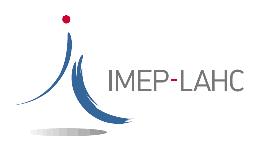Utilisation du bruit à basse fréquence des composants Semi-conducteur-Sur-Isolateur comme outil de detection bio-chimique
Publié le : 8 décembre 2021
 Utilisation du bruit à basse fréquence des composants Semi-conducteur-Sur-Isolateur comme outil de detection bio-chimique
Utilisation du bruit à basse fréquence des composants Semi-conducteur-Sur-Isolateur comme outil de detection bio-chimique
Supervisor/contact:
Christoforos Theodorou, CNRS researcher at IMEP-LAHC christoforos.theodorou@grenoble-inp.fr / 04 56 52 95 49
Scientific context:
In the wide family of bio-chemical sensors, the ISFETs (Ion Sensing Field Effect Transistors) occupy a place of honor thanks to their multiple advantages, e.g. in terms of miniaturization, sensitivity, co- integration with reading circuitry etc.¹. The working principle, known as Charge-Based Sensing (CBS) of such a device is based on the shift of the threshold voltage of a transistor, due to the intentional addition of charges-to-be-detected in the proximity of its channel.
The resulting conductivity/current modulation is then measured in (quasi)-static conditions, in which externally applied voltages are slow enough and the device is assumed at equilibrium at every measurement point. Therefore the transistor’s electrical noise can be a limiting factor for the sensor’s performance.
However, it has been demonstrated that the surface-related noise of the device can itself be used as a sensing tool². This principle, known as Fluctuation-Enhanced Sensing (FES), is based on the effects of dynamic interaction between surface traps and electrons of deposited molecules, leading
to a unique characteristic noise spectrum for each sensing target³. This approach thus promises increased sensitivity and selectivity compared to the CBS methods.
Internship objectives :
The objectives of the internship are to:
- Prove the feasibility of the FES method for different types of devices (Bottom Gate SOI FETs,Graphene FETs etc.)
- Interpret the measured results
- Benchmark the FES method against CBS in terms of sensitivity, selectivity, cost etc.
- Perform preliminary tests for pH sensing as an application
During the internship, validation of the proposed methods will be initially performed thanks to simple “model” charges such as carboxylate-functionalized polystyrene latex beads deposited on the Si (or Graphene) film surface. The interest in starting with such particles resides in the simplicity of the deposition from colloidal solutions, without any need of surface functionalization. The amount of charges can also be simply tuned by derail dilutions of the beads or mixtures of charges and uncharged beads.
Requested competences :
The internship is covering a wide panel of know-hows, from the semiconductor device physics to electrical and noise characterization. The candidate must have a very good background in physics and characterization of semiconductor devices. Knowledge of concepts in bio-chemical sensing will be a plus. The candidate is expected to enjoy experimental work and development of adapted protocols.
Scientific curiosity and motivation are mandatory qualities in order to take full advantage of the scientific environment and gain expertise for his/her future career. A continuation (not mandatory) for a PhD thesis around this topic is envisioned.
___________________________________________________________________________________________________________
¹ Bergveld, P. Sensors and Actuators B: Chemical 2003, 88, (1), 1-20; Moser, N.; Lande, T. S.; Toumazou, C.; Georgiou, P. IEEE Sensors Journal 2016, 16, (17), 6496-6514.
²Kish, L. B.; Chang, H. C.; King, M. D.; Kwan, C.; Jensen, J. O.; Schmera, G.; Smulko, J.; Gingl, Z.; Granqvist, C. G. IEEE Transactions on Nanotechnology 2011, 10, (6), 1238-1242;
³ Rumyantsev, S.; Liu, G.; Potyrailo, R. A.; Balandin, A. A.; Shur, M. S. IEEE Sensors Journal 2013, 13, (8), 2818-2822.



 Contactez-nous
Contactez-nous Plan d’accès
Plan d’accès









